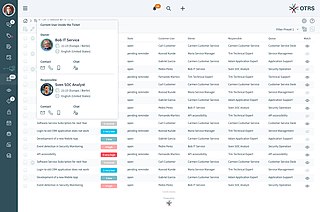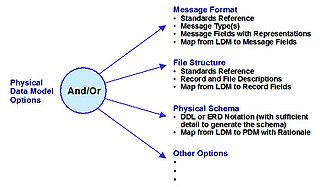
Db2 is a family of data management products, including database servers, developed by IBM. It initially supported the relational model, but was extended to support object–relational features and non-relational structures like JSON and XML. The brand name was originally styled as DB2 until 2017, when it changed to its present form.

An IT administrator, system administrator, sysadmin, or admin is a person who is responsible for the upkeep, configuration, and reliable operation of computer systems, especially multi-user computers, such as servers. The system administrator seeks to ensure that the uptime, performance, resources, and security of the computers they manage meet the needs of the users, without exceeding a set budget when doing so.
In computing, Open Database Connectivity (ODBC) is a standard application programming interface (API) for accessing database management systems (DBMS). The designers of ODBC aimed to make it independent of database systems and operating systems. An application written using ODBC can be ported to other platforms, both on the client and server side, with few changes to the data access code.
Oracle Database is a proprietary multi-model database management system produced and marketed by Oracle Corporation.
Adabas, a contraction of “adaptable database system," is a database package that was developed by Software AG to run on IBM mainframes. It was launched in 1971 as a non-relational database. As of 2019, Adabas is marketed for use on a wider range of platforms, including Linux, Unix, and Windows.
DataFlex is an object-oriented high-level programming language and a fourth generation visual tool for developing Windows, web and mobile software applications on one framework-based platform. It was introduced and developed by Data Access Corporation beginning in 1982.

OTRS is a service management suite. The suite contains an agent portal, admin dashboard and customer portal. In the agent portal, teams process tickets and requests from customers. There are various ways in which this information, as well as customer and related data can be viewed. As the name implies, the admin dashboard allows system administrators to manage the system: Options are many, but include roles and groups, process automation, channel integration, and CMDB/database options. The third component, the customer portal, is much like a customizable webpage where information can be shared with customers and requests can be tracked on the customer side.

A physical data model is a representation of a data design as implemented, or intended to be implemented, in a database management system. In the lifecycle of a project it typically derives from a logical data model, though it may be reverse-engineered from a given database implementation. A complete physical data model will include all the database artifacts required to create relationships between tables or to achieve performance goals, such as indexes, constraint definitions, linking tables, partitioned tables or clusters. Analysts can usually use a physical data model to calculate storage estimates; it may include specific storage allocation details for a given database system.
The following tables compare general and technical information for a number of relational database management systems. Please see the individual products' articles for further information. Unless otherwise specified in footnotes, comparisons are based on the stable versions without any add-ons, extensions or external programs.
IBM Storage Protect is a data protection platform that gives enterprises a single point of control and administration for backup and recovery. It is the flagship product in the IBM Spectrum Protect family.
To quiesce is to pause or alter a device or application to achieve a consistent state, usually in preparation for a backup or other maintenance.
In database computing, Oracle Real Application Clusters (RAC) — an option for the Oracle Database software produced by Oracle Corporation and introduced in 2001 with Oracle9i — provides software for clustering and high availability in Oracle database environments. Oracle Corporation includes RAC with the Enterprise Edition, provided the nodes are clustered using Oracle Clusterware.
Embedded SQL is a method of combining the computing power of a programming language and the database manipulation capabilities of SQL. Embedded SQL statements are SQL statements written inline with the program source code, of the host language. The embedded SQL statements are parsed by an embedded SQL preprocessor and replaced by host-language calls to a code library. The output from the preprocessor is then compiled by the host compiler. This allows programmers to embed SQL statements in programs written in any number of languages such as C/C++, COBOL and Fortran. This differs from SQL-derived programming languages that don't go through discrete preprocessors, such as PL/SQL and T-SQL.
Address Windowing Extensions (AWE) is a Microsoft Windows application programming interface that allows a 32-bit software application to access more physical memory than it has virtual address space, even in excess of the 4 GB limit. The process of mapping an application's virtual address space to physical memory under AWE is known as "windowing", and is similar to the overlay concept of other environments. AWE is beneficial to certain data-intensive applications, such as database management systems and scientific and engineering software, that need to manipulate very large data sets while minimizing paging.
Database administration is the function of managing and maintaining database management systems (DBMS) software. Mainstream DBMS software such as Oracle, IBM Db2 and Microsoft SQL Server need ongoing management. As such, corporations that use DBMS software often hire specialized information technology personnel called database administrators or DBAs.
The DUAL table is a special one-row, one-column table present by default in Oracle and other database installations. In Oracle, the table has a single VARCHAR2(1) column called DUMMY that has a value of 'X'. It is suitable for use in selecting a pseudo column such as SYSDATE or USER.
Configurable Network Computing or CNC is JD Edwards's (JDE) client–server proprietary architecture and methodology. Now a division of the Oracle Corporation, Oracle continues to sponsor the ongoing development of the JD Edwards Enterprise Resource Planning (ERP) system, While highly flexible, the CNC architecture is proprietary and, as such, it cannot be exported to any other systems. While the CNC architecture's chief 'Claim to fame', insulation of applications from the underlying database and operating systems, were largely superseded by modern web-based technology, nevertheless CNC technology continues to be at the heart of both JD Edwards' One World and Enterprise One architecture and is planned to play a significant role Oracle's developing fusion architecture initiative. While a proprietary architecture, CNC is neither an Oracle nor JDE product offering. The term CNC also refers to the systems analysts who install, maintain, manage and enhance this architecture. CNC's are also one of the three technical areas in the JD Edwards Enterprise Resource Planning ERP which include developer/report writer and functional/business analysts.
pureXML is the native XML storage feature in the IBM Db2 data server. pureXML provides query languages, storage technologies, indexing technologies, and other features to support XML data. The word pure in pureXML was chosen to indicate that Db2 natively stores and natively processes XML data in its inherent hierarchical structure, as opposed to treating XML data as plain text or converting it into a relational format.
Transparent Data Encryption is a technology employed by Microsoft, IBM and Oracle to encrypt database files. TDE offers encryption at file level. TDE solves the problem of protecting data at rest, encrypting databases both on the hard drive and consequently on backup media. It does not protect data in transit nor data in use. Enterprises typically employ TDE to solve compliance issues such as PCI DSS which require the protection of data at rest.
Microsoft Certified Professional was a certification program from Microsoft.



